Combination of Herbicide Band Application and Inter-Row Cultivation Provides Sustainable Weed Control in Maize
Abstract
1. Introduction
2. Materials and Methods
2.1. Experimental Design and General Agronomic Management
2.2. Data Collection and Analysis
3. Results
3.1. Weather Data
3.2. Herbicide Application
3.3. Weed Composition and Density
3.4. Maize Yield
4. Discussion
5. Conclusions
Supplementary Materials
Author Contributions
Funding
Acknowledgments
Conflicts of Interest
References
- Rohr, J.R.; McCoy, K.A. A qualitative meta-analysis reveals consistent effects of atrazine on freshwater fish and amphibians. Environ. Health Persp. 2010, 118, 20–32. [Google Scholar] [CrossRef] [PubMed]
- Narushima, T.; Sato, T.; Goto, Y.; Takahashi, Y. Pesticides in river and tap water in rice production area of Niigata, Japan. Water Air Soil Pollut. 2014, 225, 2229. [Google Scholar] [CrossRef]
- Boutin, C.; Stranberg, B.; Carpenter, D.; Mathiassen, S.K.; Thomas, P.J. Herbicide impact on non-target plant reproduction: What are the toxicological and ecological implications? Environ. Pollut. 2014, 185, 295–306. [Google Scholar] [CrossRef] [PubMed]
- ISPRA (Istituto Superiore per la Protezione e la Ricerca Ambientale). Rapporto Nazionale Pesticidi Nelle Acque: Dati 2015–16. Rapporti 2018, 282. Available online: http://www.isprambiente.gov.it/it/pubblicazioni/rapporti/rapporto-nazionale-pesticidi-nelle-acque-dati-2015-2016.-edizione-2018 (accessed on 28 May 2019).
- Liebman, M.; Baraibar, B.; Buckley, Y.; Childs, D.; Christensen, S.; Cousens, R.; Eizenberg, H.; Heijting, S.; Loddo, D.; Merotto, J.A.; et al. Ecologically sustainable weed management: How do we get from proof-of-concept to adoption? Ecol. Appl. 2016, 26, 1352–1369. [Google Scholar] [CrossRef] [PubMed]
- Barzman, M.; Bàrberi, P.; Birch, A.N.E.; Boonekamp, P.; Dachbrodt-S, S.; Graf, B.; Hommel, B.; Erik, J.J.; Kiss, J.; Kudsk, P.; et al. Eight principles of integrated pest management. Agron. Sustain. Dev. 2015, 35, 1199–1215. [Google Scholar] [CrossRef]
- European Parliament. Directive 2009/128/EC of the European Parliament and of the Council of 21 October 2009 establishing a framework for Community action to achieve the sustainable use of pesticides. Off. J. Eur. Union 2009, 309, 71–86. [Google Scholar]
- Bastiaans, L.; Paolini, R.; Baumann, D.T. Focus on ecological weed management: What is hindering adoption? Weed Res. 2008, 48, 481–491. [Google Scholar] [CrossRef]
- Deytieux, V.; Nemecek, T.; Freiermuth-Knuchel, R.; Gaillard, G.; Munier-Jolain, N.M. Is integrated weed management efficient for reducing environmental impacts of cropping systems? A case study based on life cycle assessment. Eur. J. Agron. 2012, 36, 55–65. [Google Scholar] [CrossRef]
- Meissle, M.; Mouron, P.; Musa, T.; Bigler, F.; Pons, X.; Vasileiadis, V.P.; Otto, S.; Antichi, D.; Kiss, J.; Pálinkás, Z.; et al. Pests, pesticide use and alternative options in European maize production: Current status and future prospects. J. Appl. Entomol. 2010, 134, 357–375. [Google Scholar] [CrossRef]
- Manalil, S.; Busi, R.; Renton, M.; Powles, S.B. Rapid evolution of herbicide resistance by low herbicide dosages. Weed Sci. 2011, 59, 210–217. [Google Scholar] [CrossRef]
- Gressel, J. Evolving understanding of the evolution of herbicide resistance. Pest Manag. Sci. 2009, 65, 1164–1173. [Google Scholar] [CrossRef] [PubMed]
- Vasileiadis, V.P.; Otto, S.; van Dijk, W.; Urek, G.; Leskovšek, R.; Verschwele, A.; Furlan, L.; Sattin, M. On-farm evaluation of integrated weed management tools for maize production in three different agro-environments in Europe: Agronomic efficacy, herbicide use reduction, and economic sustainability. Eur. J. Agron. 2015, 63, 71–78. [Google Scholar] [CrossRef]
- Vasileiadis, V.P.; van Dijk, W.; Verschwele, A.; Holb, I.J.; Vámos, A.; Urek, G.; Leskovšek, R.; Furlan, L.; Sattin, M. Farm-scale evaluation of herbicide band application integrated with inter-row mechanical weeding for maize production in four European regions. Weed Res. 2016, 56, 313–322. [Google Scholar] [CrossRef]
- Pannacci, E.; Tei, F. Effects of mechanical and chemical methods on weed control, weed seed rain and crop yield in maize, sunflower and soyabean. Crop Prot. 2014, 64, 51–59. [Google Scholar] [CrossRef]
- Keene, C.L.; Curran, W.S. Optimizing high-residue cultivation timing and frequency in reduced-tillage soybean and corn. Agron. J. 2016, 108, 1897–1906. [Google Scholar] [CrossRef]
- Main, D.C.; Sanderson, K.R.; Fillmore, S.A.E.; Ivany, J.A. Comparison of synthetic and organic herbicides applied banded for weed control in carrots (Daucus carota L.). Can. J. Plant Sci. 2013, 93, 857861. [Google Scholar] [CrossRef]
- Ivany, J.A. Banded herbicides and cultivation for weed control in potatoes (Solanum tuberosum L.). Can. J. Plant Sci. 2002, 82, 617–620. [Google Scholar] [CrossRef]
- Perez-Ruiz, M.; Carballido, J.; Agüera, J.; Rodríguez-Lizana, A. Development and evaluation of a combined cultivator and band sprayer with a row-centering RTK-GPS guidance system. Sensors 2013, 13, 3313–3330. [Google Scholar] [CrossRef]
- Kottek, M.; Grieser, J.; Beck, C.; Rudolf, B.; Rubel, F. World map of the Köppen-Geiger climate classification updated. Meteorol. Z. 2006, 15, 259–263. [Google Scholar] [CrossRef]
- Kunz, C.; Weber, J.; Gerhards, R. Benefits of precision farming technologies for mechanical weed control in soybean and sugar beet—Comparison of precision hoeing with conventional mechanical weed control. Agronomy 2015, 5, 130–142. [Google Scholar] [CrossRef]
- Kunz, C.; Weber, J.F.; Peteinatos, G.G.; Sökefeld, M.; Gerhards, R. Camera steered mechanical weed control in sugar beet, maize and soybean. Precis. Agric. 2018, 19, 708–710. [Google Scholar] [CrossRef]
- Peruzzi, A.; Martelloni, L.; Frasconi, C.; Fontanelli, M.; Pirchio, M.; Raffaelli, M. Machines for non-chemical intra-row weed control in narrow and wide-row crops: A review. J. Agric. Eng. 2017, 48, 57–70. [Google Scholar] [CrossRef]
- Adeux, G.; Munier-Jolain, N.; Meunier, D.; Farcy, P.; Carlesi, S.; Barberi, P.; Cordeau, S. Diversified grain-based cropping systems provide long-term weed control while limiting herbicide use and yield losses. Agron. Sustain. Dev. 2019, 39, 42. [Google Scholar] [CrossRef]
- Li, J.; Huang, L.; Zhang, J.; Coulter, J.A.; Li, L.; Gan, Y. Diversifying crop rotation improves system robustness. Agron. Sustain. Dev. 2019, 39, 38. [Google Scholar] [CrossRef]
- San Martín, C.; Long, D.S.; Gourlie, J.A.; Barroso, J. Spring crops in three year rotations reduce weed pressure in winter wheat. Field Crop. Res. 2019, 233, 12–20. [Google Scholar] [CrossRef]
- Andújar, D.; Barroso, J.; Fernández-Quintanilla, C.; Dorado, J. Spatial and temporal dynamics of Sorghum halepense patches in maize crops. Weed Res. 2012, 52, 411–420. [Google Scholar] [CrossRef]
- San Martín, C.; Andújar, D.; Fernández-Quintanilla, C.; Dorado, J. Spatio-temporal dynamics of Sorghum halepense in poplar short-rotation coppice under several vegetation management systems. For. Ecol. Manag. 2016, 379, 37–49. [Google Scholar] [CrossRef]
- Andújar, D.; Ribeiro, A.; Fernández-Quintanilla, C.; Dorado, J. Herbicide savings and economic benefits of several strategies to control Sorghum halepense in maize crops. Crop Prot. 2013, 50, 17–23. [Google Scholar] [CrossRef]
- Panozzo, S.; Scarabel, L.; Rosan, V.; Sattin, M. A new Ala-122-Asn amino acid change confers decreased fitness to ALS-resistant Echinochloa crus-galli. Front. Plant Sci. 2017, 8, 2042. [Google Scholar] [CrossRef]
- Milani, A.; Scarabel, L.; Sattin, M. A family affair: resistance mechanism and alternative control of three Amaranthus species resistant to acetolactate synthase inhibitors in Italy. Pest Manag. Sci. 2019. [Google Scholar] [CrossRef]
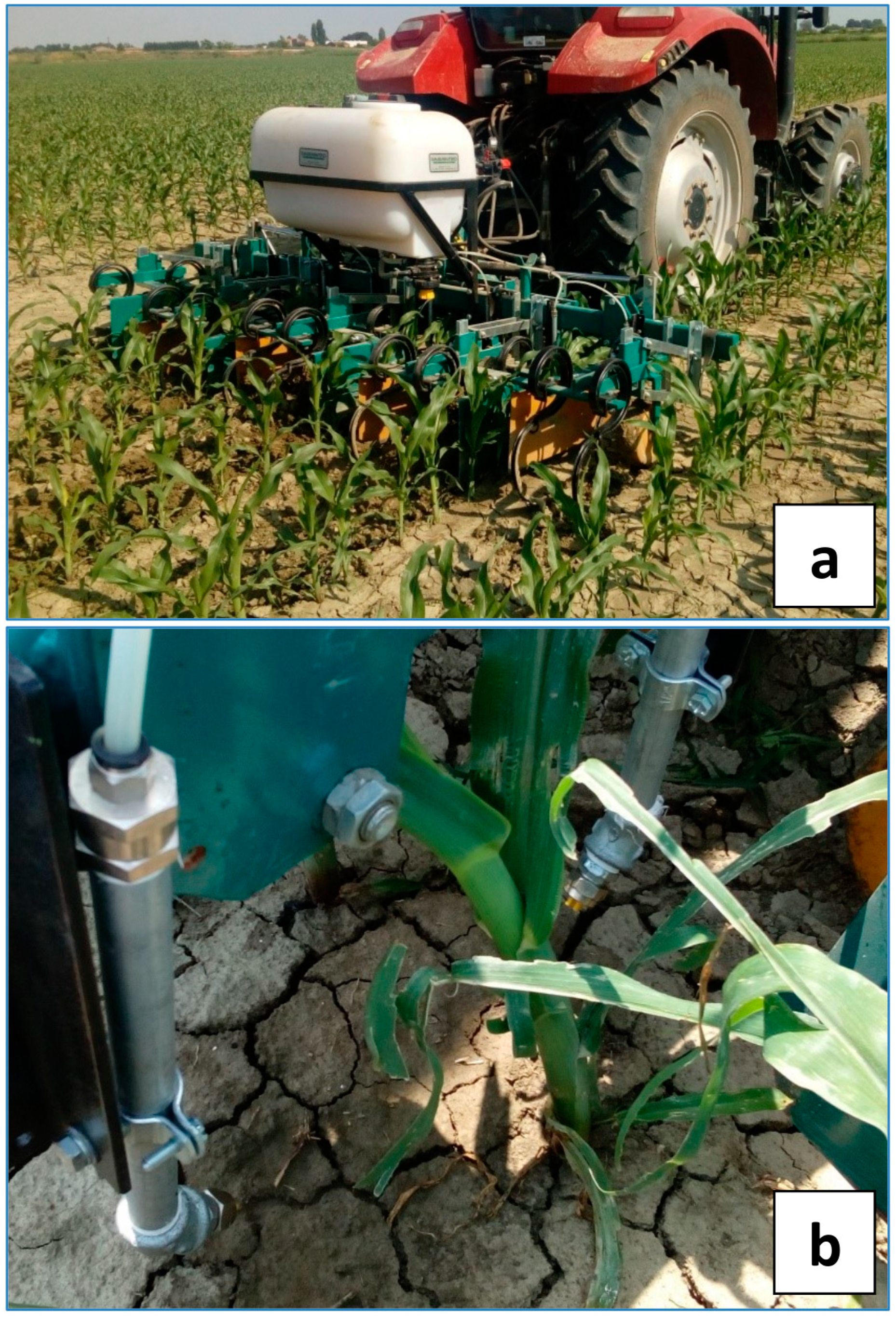
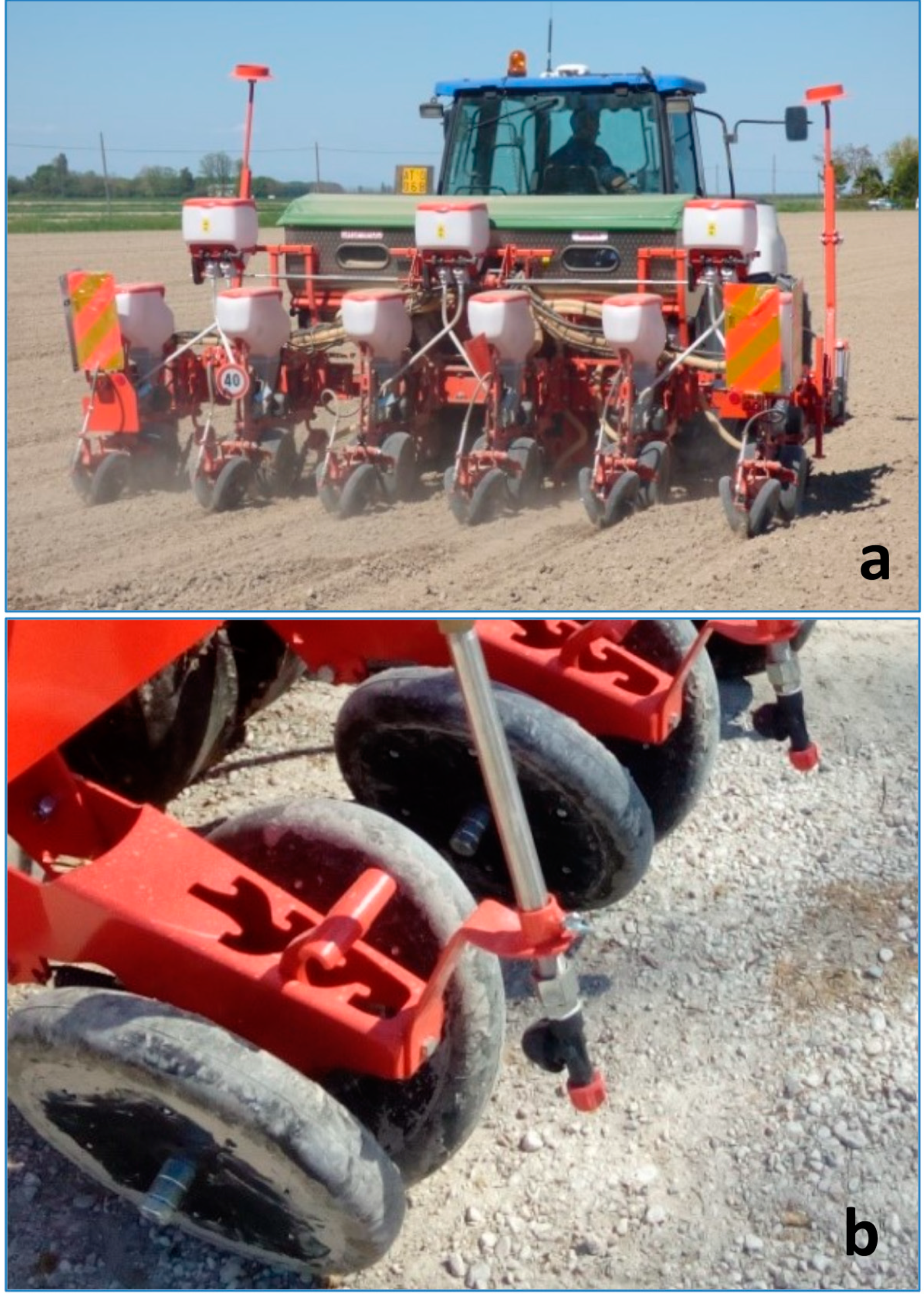
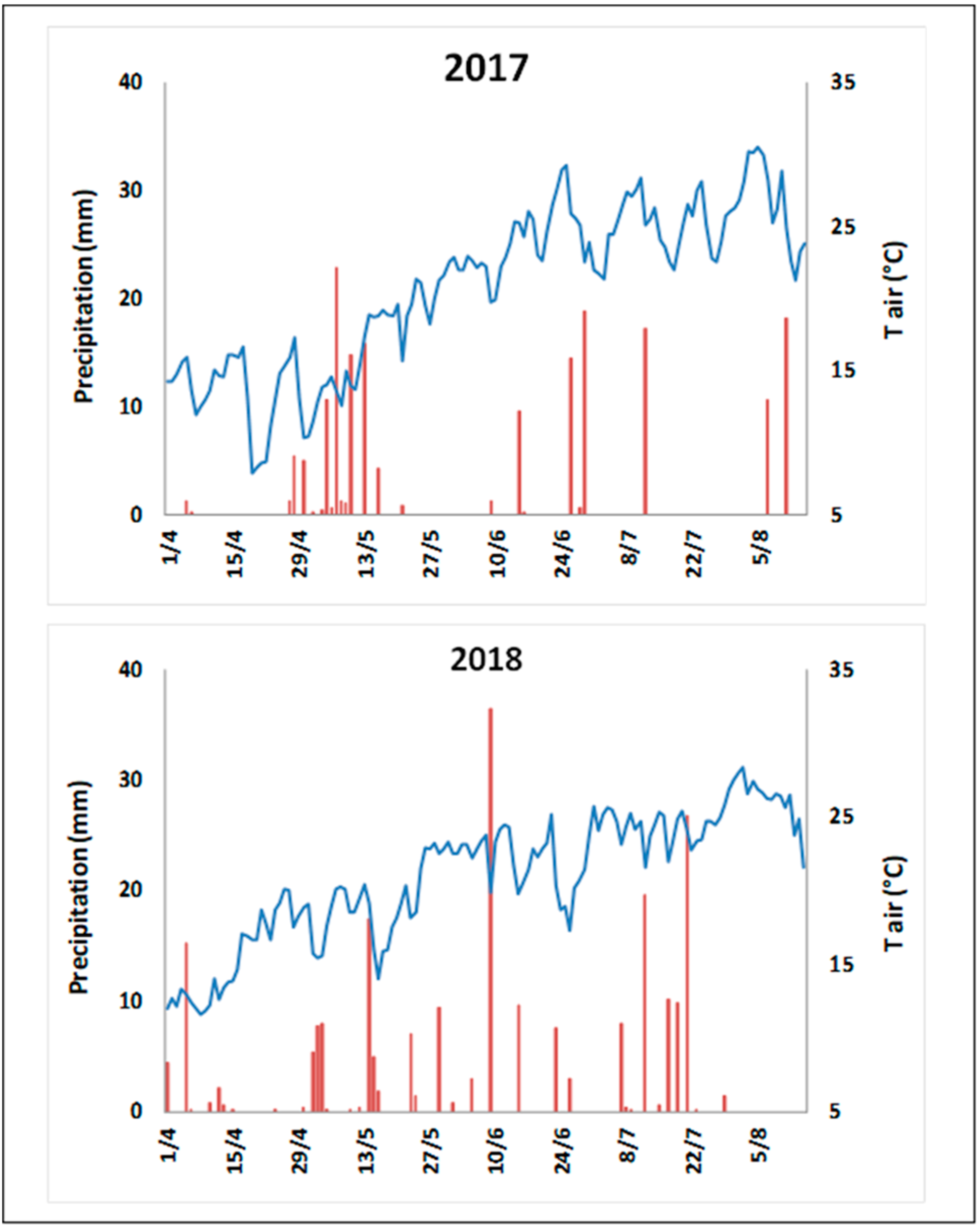
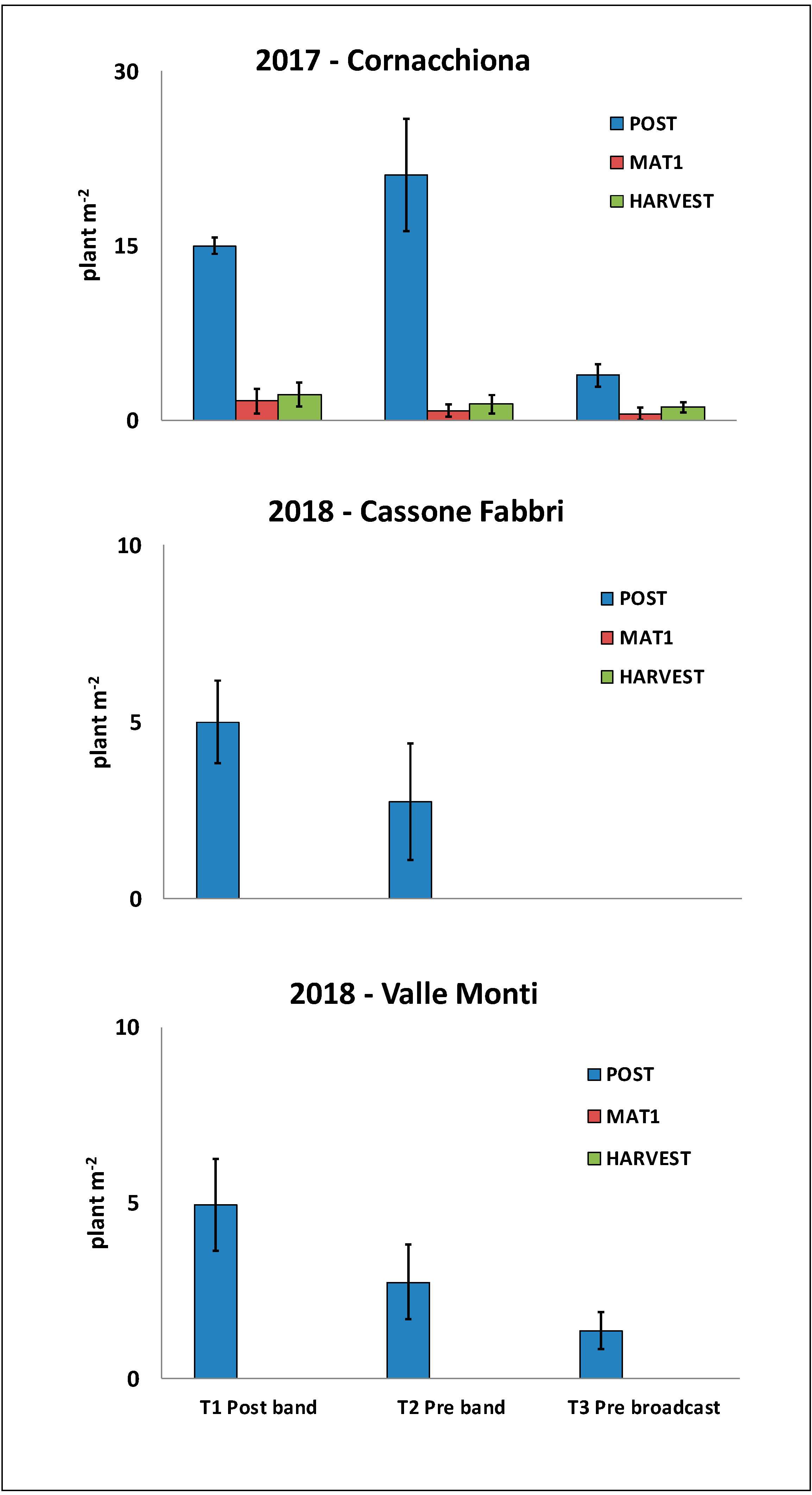
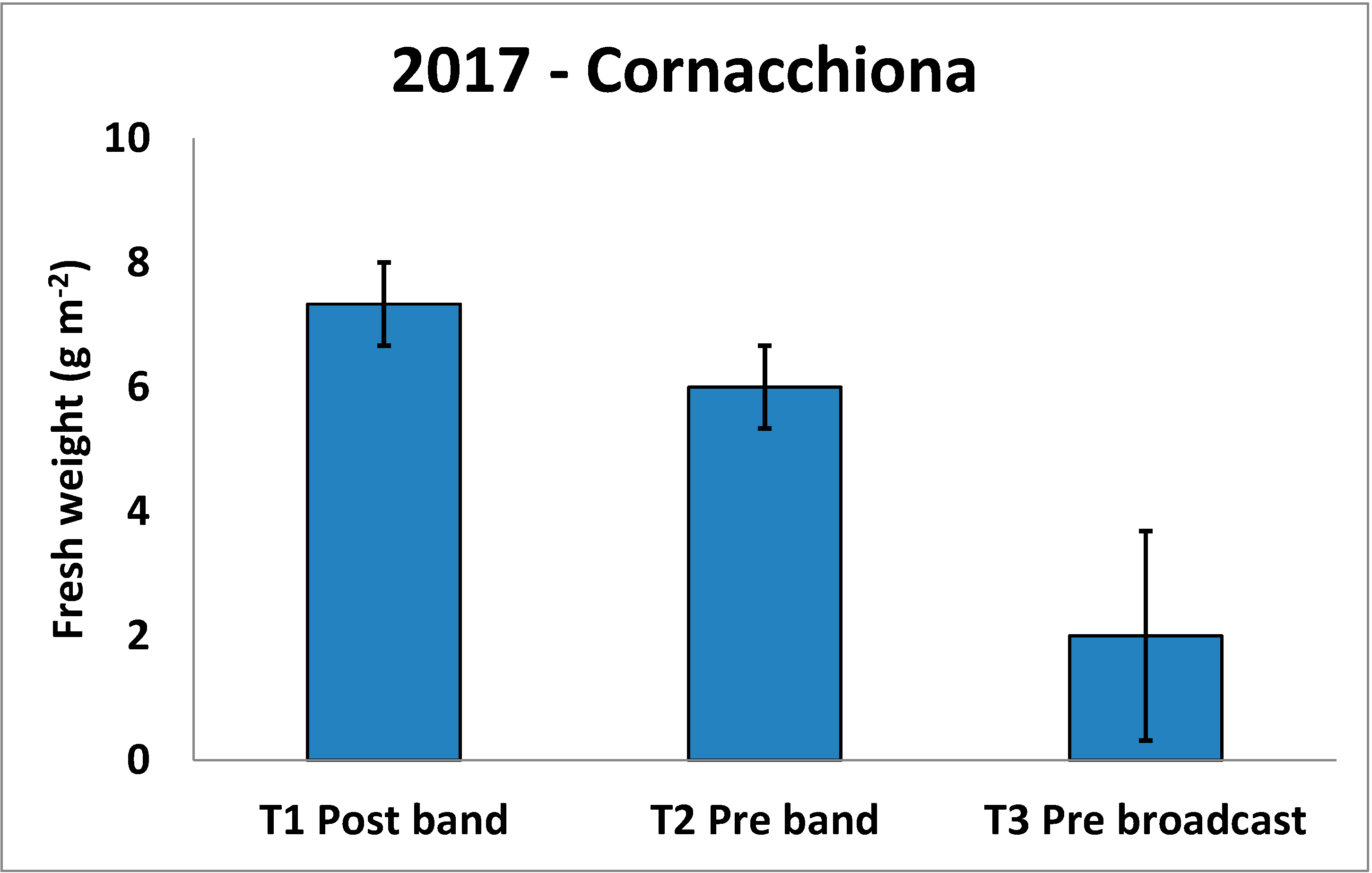
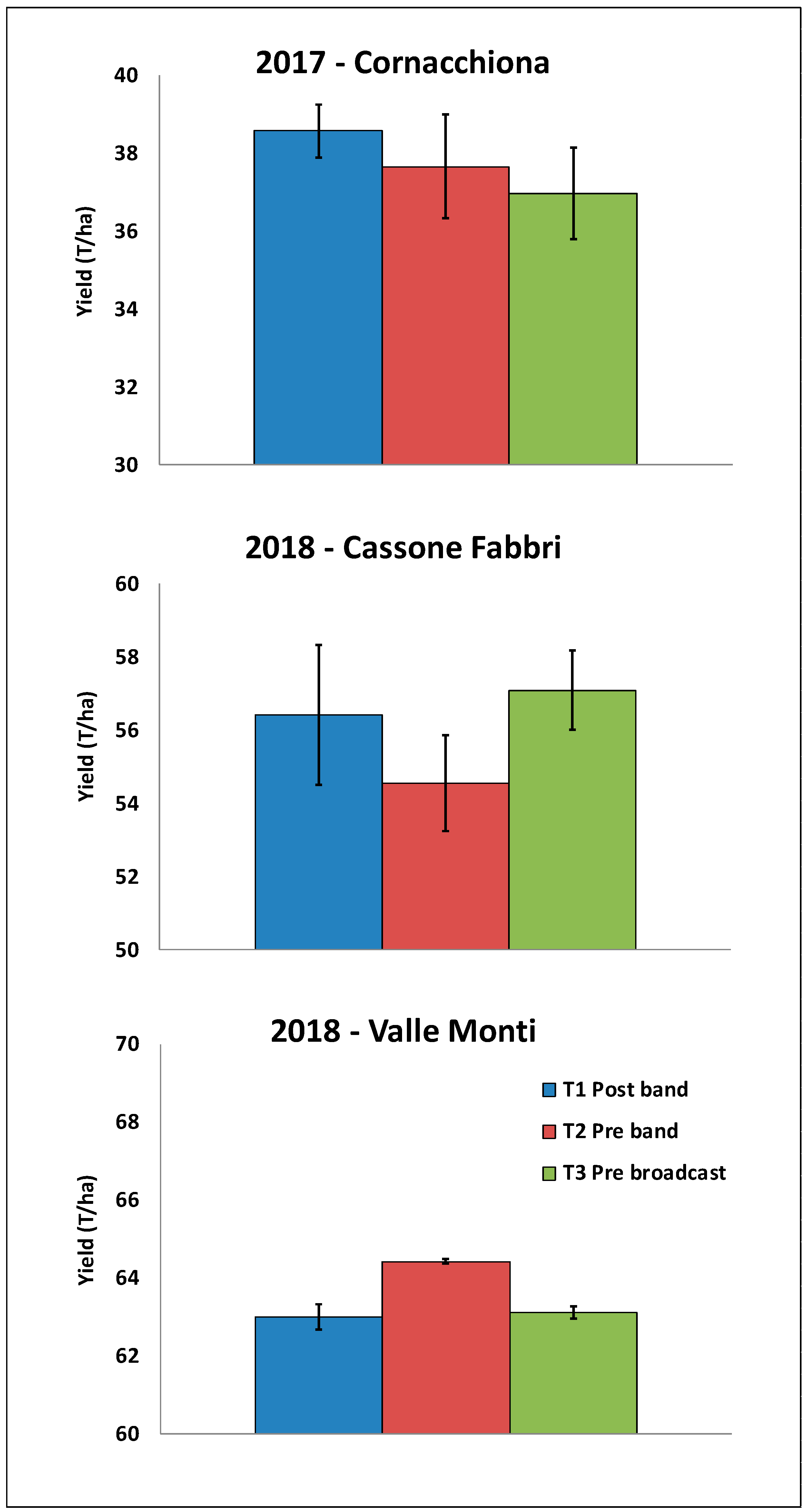
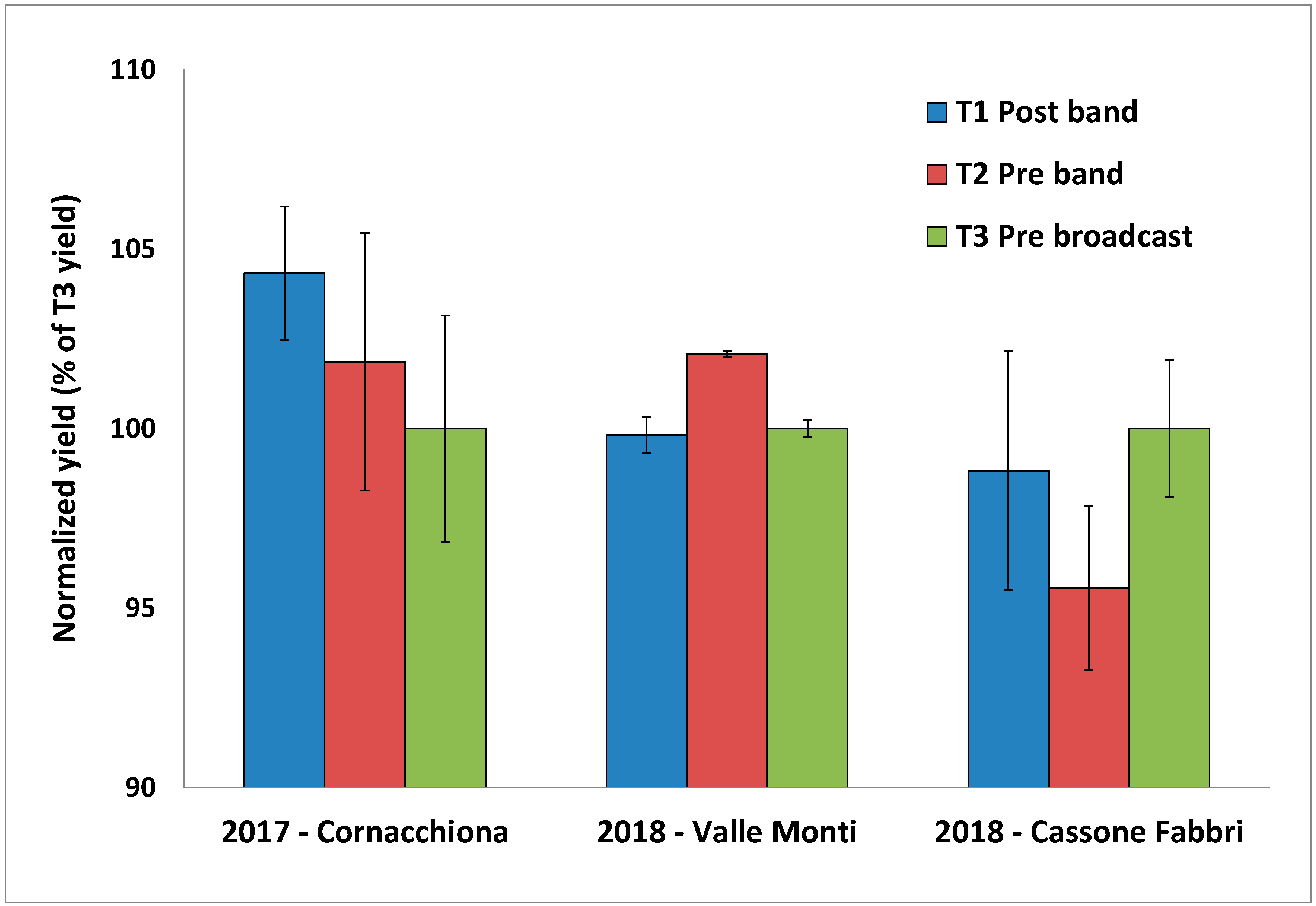
| Application | % of Treated Area | Theoretical Spray Volume on Treated Area | Measured Spray Volume on Whole Area 1 | |
|---|---|---|---|---|
| (L ha−1) | (L ha−1) | |||
| T1 | Band Post-emergence | 50% | 300 | 150 ± 10 |
| (37.5 cm-wide band) | ||||
| T2 | Band Pre-emergence | 33% | 300 | 100 ± 3 |
| (25 cm-wide band) | ||||
| T3 | Broadcast Pre-emergence | 100% | 200 | 200 ± 5 |
| Application | Herbicides | Theoretical Dose on Treated Area | Estimated Dose on Whole Area 1 | |
| (a.i.) | (g a.i. ha−1) | (g a.i. ha−1) | ||
| T1 | Band Post-emergence | mesotrione | 60 | 30 ± 2.0 |
| prosulfuron | 15 | 7.5 ± 0.5 | ||
| T2 | Band Pre-emergence | thiencarbazone-methyl | 36 | 12 ± 0.4 |
| isoxaflutolo | 90 | 30 ± 0.9 | ||
| T3 | Broadcast Pre-emergence | thiencarbazone-methyl | 36 | 36 ± 0.6 |
| isoxaflutolo | 90 | 90 ± 1.5 |
| T1 Post Band | T2 Pre Band | T3 Pre Broadcast | |
|---|---|---|---|
| 03/04/17 17/04/18 | Crop sowing Broadcast glyphosate application | Crop sowing Broadcast glyphosate application | Crop sowing Broadcast glyphosate application |
| 03/04/17 17/04/18 | Pre-emergence band application | Pre-emergence broadcast application | |
| 12/05/17 25/05/18 | 1° weed assessment | 1° weed assessment | 1° weed assessment |
| 23/05/17 25/05/18 | Post-emergence band application | ||
| 23/05/17 25/05/18 | Inter-row hoeing | Inter-row hoeing | Inter-row hoeing |
| 13/06/17 26/06/18 | 2° weed assessment | 2° weed assessment | 2° weed assessment |
| 27/07/17 30/07/18 | 3° weed assessment | 3° weed assessment | 3° weed assessment |
| 09/08/17 11/08/18 | Crop harvest | Crop harvest | Crop harvest |
| Species | Plants m−2 |
|---|---|
| 2017 Cornacchiona | |
| Abutilon theophrasti | 0.3 |
| Amaranthus retroflexus | 3.6 |
| Chenopodium album | 0.8 |
| Convolvulus | 0.8 |
| Echinocloa crus-galli | 0.3 |
| Fallopia convolvulus | 0.3 |
| Polygonum persicaria | 0.6 |
| Portulaca oleracea | 0.3 |
| Solanum nigrum | 8.1 |
| Total | 15.0 |
| 2018 Valle Monti | |
| Convolvulus arvensis | 2.5 |
| Echinocloa crus-galli | 1.9 |
| Fallopia convolvulus | 0.3 |
| Setaria viridis | 0.3 |
| Total | 5.0 |
| 2018 Cassone Fabbri | |
| Echinocloa crus-galli | 0.6 |
| Polygonum persicaria | 2.2 |
| Setaria glauca | 0.6 |
| Setaria viridis | 0.6 |
| Solanum nigrum | 1.0 |
| Total | 5.0 |
© 2019 by the authors. Licensee MDPI, Basel, Switzerland. This article is an open access article distributed under the terms and conditions of the Creative Commons Attribution (CC BY) license (http://creativecommons.org/licenses/by/4.0/).
Share and Cite
Loddo, D.; Scarabel, L.; Sattin, M.; Pederzoli, A.; Morsiani, C.; Canestrale, R.; Tommasini, M.G. Combination of Herbicide Band Application and Inter-Row Cultivation Provides Sustainable Weed Control in Maize. Agronomy 2020, 10, 20. https://doi.org/10.3390/agronomy10010020
Loddo D, Scarabel L, Sattin M, Pederzoli A, Morsiani C, Canestrale R, Tommasini MG. Combination of Herbicide Band Application and Inter-Row Cultivation Provides Sustainable Weed Control in Maize. Agronomy. 2020; 10(1):20. https://doi.org/10.3390/agronomy10010020
Chicago/Turabian StyleLoddo, Donato, Laura Scarabel, Maurizio Sattin, Antonio Pederzoli, Chiara Morsiani, Renato Canestrale, and Maria Grazia Tommasini. 2020. "Combination of Herbicide Band Application and Inter-Row Cultivation Provides Sustainable Weed Control in Maize" Agronomy 10, no. 1: 20. https://doi.org/10.3390/agronomy10010020
APA StyleLoddo, D., Scarabel, L., Sattin, M., Pederzoli, A., Morsiani, C., Canestrale, R., & Tommasini, M. G. (2020). Combination of Herbicide Band Application and Inter-Row Cultivation Provides Sustainable Weed Control in Maize. Agronomy, 10(1), 20. https://doi.org/10.3390/agronomy10010020






